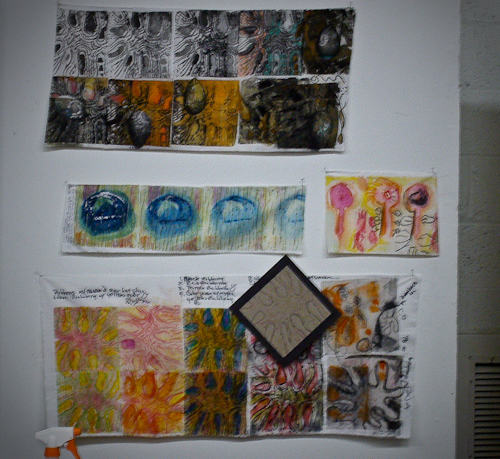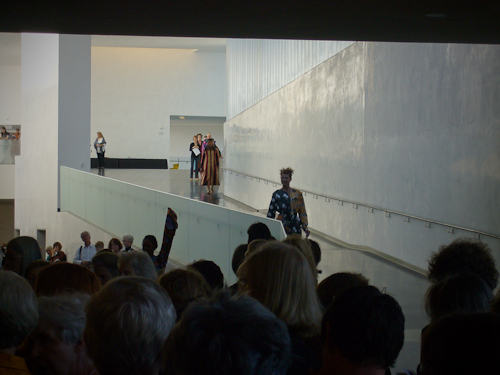Kerr Grabowski, May 2009. Photo by Deidre Adams.
Today’s SDA conference agenda included a variety of lectures and demos related to textile arts. The most inspiring for me today was a demo by Kerr Grabowski, in which she shared her techniques for working with things normally associated with art on paper — like charcoal, graphite, pastels, and water-soluble media — and making them permanent on fabric. Kerr is known for her beautiful garments and her innovative explorations in screenprinting techniques.
Samples Kerr made using her new process:
I had taken Kerr’s workshop on deconstructed screen printing years ago, and I remember how much fun it was and what great marks could be made on fabric using this process. I still have some really beautiful fabrics that I made in that workshop. Kerr is a generous, sharing person (she even provides a video of the DSP process right on her home page), and her enthusiasm for the process is infectious. She started her demo by saying that she wished her audience to try some of these processes and to let her know what we discover; she wants to start a dialog of artists working together. I left the demo wishing I could go home right then and start playing with some of these techniques.
Later I attended a lecture by Dr. Maria Elena Buszek titled “Minding the Margins: Craft, Criticism and Contemporary Art.” It had to do with the divide between craft and art, but I have to be honest — she talked so fast and furiously I couldn’t keep up with her and I’m not sure even now what her point was, except maybe that so-called “craft” artists should try harder to place themselves in the wider art milieu and expose ourselves to criticism in that realm. She has a Ph.D. in art history, so her view must necessarily be somewhat academic. As textile artists, we can all decide for ourselves whether any of this matters to our pursuit of happiness or fame and fortune or whatever it is we seek in the long run. Evidently she is ruffling some feathers, but I confess to not knowing a lot about this topic. She did give several references for reading which I have put on my to-do list.
The day was capped off by “Textile Fusion: An Interactive Fashion Performance.”
The logistics of the thing weren’t well planned, and nobody seemed to know where they should stand or where the action was going to be headed. It was all very conceptual, with live music that at first seemed pleasantly appropriate but which soon turned relentless and repetitive. Plus, the whole fashion thing in general is very much beyond me, and wearable art is no exception. However, the planners had the good sense to hold the show in the Bloch Building at the Nelson Atkins Museum of Art. This was my second visit to the museum, and as I had not had time to get to this part of it earlier, I found a ready opportunity to escape this scene and immerse myself in the quiet solitude of cavernous halls full of good old-fashioned modern art for a refreshing change of pace.
The collection holds a good variety of Abstract Expressionists:
Jackson Pollock (left) and Willem DeKooning (right)
They also have a wide variety of all your modern, postmodern, minimalist, and pop favorites, including Rothko, Kline, Diebenkorn, Warhol, Oldenburg, Rauschenberg, Rosenquist, Judd, LeWitt, Martin, Murry, Riley, and several Thiebauds. One of the more interesting is a huge painting by Kerry James Marshall done on banner canvas, called Memento #5, celebrating the Civil Rights movement of the 1960s.
One of the most interesting exhibits in the museum is an exhibition of photographs by Homer Page, a mostly unknkown photographer who created this body of work in 1949-50 in fulfillment of a Guggenheim fellowship. They are street scenes of New York City, often including images of advertisements in ironic juxtaposition with ordinary people. According to the museum’s promo page, this work “represents a ‘missing link’ between the warm, humanistic, and socially motivated documentary photographs of the 1930s and early 1940s in the works of Dorothea Lange, and the tougher, grittier and more existential work of the later 1950s as seen in the images of Robert Frank.” I would love to have more time to go back and look at these again. May just have to order the book instead.





Deidre, thank you for sharing so much of your SDA experience here and on your last post. I felt as if we were sitting together at the lecture and demonstrations, sneaking off to see the Rothko and the Kerry James Marshall huge painting on cloth. I went to the 2007 SDA conference, Mind and Body and really loved it – and learned so much. I’m not used to so many people buzzing and found that stimulating some of the time, bothersome most of the time. I loved seeing all the art however. I envy you that you got to see Alice Kettle up close and also El Anatsu. I would love to see both of their work. thanks again, you write a very interesting blog. Congratulations on that.
Judy, thanks for the comments. I feel pretty much the same way you do about these things, of mixed emotions. There’s so much to see and I learn a lot, but then being around hordes of people gets tiring. The exhibits were definitely the best part of the conference; I really loved being able to see all this work in person after just seeing it in pictures.
Deidre – you captured the city and the conference beautifully. I so enjoyed seeing much of it with you and then through your eyes via these photographs — I know my experience was and is richer for it. Thank you! And onward we go — I’m full of new energy for stitching and painting.